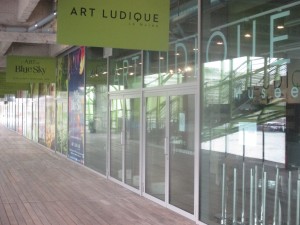
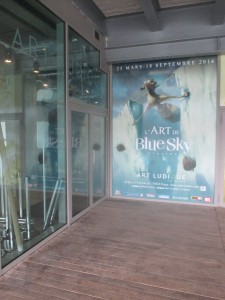
Abolishing the boundaries between comics, mangas, video games, live action cinema and animation films, Art Ludique highlights the works of creators of universes, that mark our imaginations and influence the culture of our century.
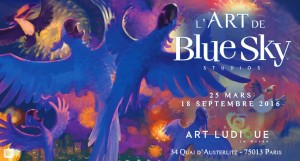
Over 800 artworks, drawings, paintings, sculptures, interviews and exclusive video projections will allow you to admire the creation of universes such as the impressive caves in Ice Age, the Amazonian waterfall in Rio 2, the metallic city in Robots, the secret lair of the Leafmen in Epic… and to discover how Blue Sky Studios created popular characters like Sid, Manny and Diego, the parrots Blu and Jewel, how they interpreted Snoopy… and of course the irresistible Scrat!
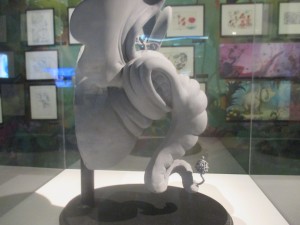
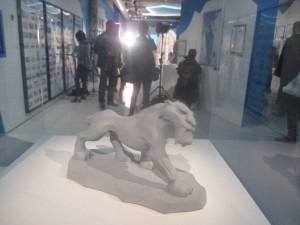
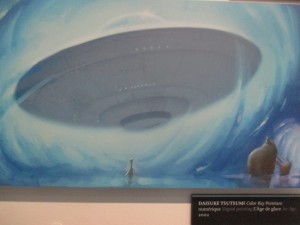
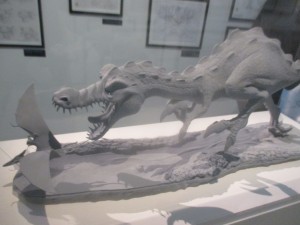
Creators of Universes
With the arrival of computer-generated images, the 1990s triggered an important turning point in animation. The blooming of feature films and shorts during this era generated the enthusiasm of viewers and the fervor of artists who greatly benefited from this new tool for their imagination. Blue Sky Studios, following its first creative experimentations for television commercials and visual effects for Hollywood blockbusters, naturally finds its place in this new artistic landscape. In 1998, the Studio´s first short, Bunny, received the Academy Award for Best Animated Short. The subsequent feature films, Ice Age, Robots Rio and Epic, distinguish themselves thanks to their singular visual identity.Their universes offer such different aesthetics that no specific „Blue Sky style“ appears across these films, instead each movie showcases a truly unique style, whose incredible richness can be discovered from the very first drawings. The artists of Blue Sky Studios create worlds enhanced by the conrasted use of light and color, constantly inviting us to change perspectives and scales.
A Universe of Characters and Creatures
From the furry creatures in Ice Age to the community of Leafmen in Epic, the mechanical beings inRobots and the colorful birds in Rio, the characters and creatures that inhabit Blue Sky Studios´movies all embody very different styles.
The incredible bestiary of the Ice Age Saga starts with Peter de Sève`smasterful pencil stroke. Their expressive postures and exuberant emotions demonstrate the artist`sexperience in editorial illustration, which naturally leads to the creation of characters both appealing and unforgettable, such as the legendary Scrat.
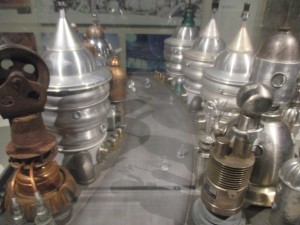 Composed of bolts and metallic parts of all sorts, the heroes of Robots share some characteristics of the steampunk aesthetic, revisited through the illustrative style of the artist William Joyce who collaborated with director Chris Wedge and lead character designer Greg Couch to develop the look of the characters. Particular attention was given to the lines drawn with delicacy and a great level of detail that confer an original and unique visual identityto these tinkered silhouettes.
Composed of bolts and metallic parts of all sorts, the heroes of Robots share some characteristics of the steampunk aesthetic, revisited through the illustrative style of the artist William Joyce who collaborated with director Chris Wedge and lead character designer Greg Couch to develop the look of the characters. Particular attention was given to the lines drawn with delicacy and a great level of detail that confer an original and unique visual identityto these tinkered silhouettes.
The character studies for Rio and Rio 2 benefit from an entirely different artistic approach. The curved shapes  characterizing Sergio Pablos`and Sang Jun Lee`s drawings lead to a dynamic graphic rhythm that mirrors the spectacular atmospheres in the two movies. This in-depth work on lines offers an impression of intense movementbefore the birds are even brought to life, fly or dance on screen.
characterizing Sergio Pablos`and Sang Jun Lee`s drawings lead to a dynamic graphic rhythm that mirrors the spectacular atmospheres in the two movies. This in-depth work on lines offers an impression of intense movementbefore the birds are even brought to life, fly or dance on screen.
Greg Couch`s ethereal style and hatched strokes can be found in the studies for the feature film Epic displayed here. The lenghty reflective and creative process that surrounds the Leafmen, which sometimes recalls insects or tiny samurai, is revealed through numerous artworks. These works reveal the talent of the Blue Sky Studios artistsat exploring graphic territories while constantly renewing them through their unrestrained imaginations.
The sculptures presented in this hall were built during the production phase and are based upon silhouettes that originatefrom the character studies. The sculptors translate the illusion of life and personality they hold into volume. This collaborative work helps to place the finishing touches of the design of the characters.

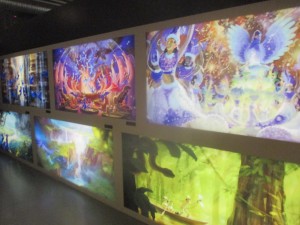
A Wold of Ice
If the Ice Age has always elicited a cold and austere environment, that all changes in 2002 as it becomes the 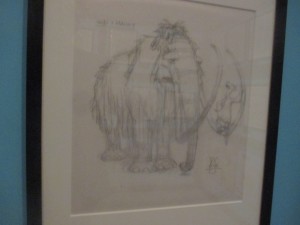 stage for a big fun adventure sprinkled with laughter with Blue Sky `s first feature film. The five movies of the Ice Age saga are artistically renewed through the diversity of themes, generating both an abundance and a variety of sceneries, created in order to welcome new landscapes and new characters: melting ice caps and sea monsters, lush tropical forests and dinosaurs, vast oceans and pirates, or even outer space and its surprising inhabitants.
stage for a big fun adventure sprinkled with laughter with Blue Sky `s first feature film. The five movies of the Ice Age saga are artistically renewed through the diversity of themes, generating both an abundance and a variety of sceneries, created in order to welcome new landscapes and new characters: melting ice caps and sea monsters, lush tropical forests and dinosaurs, vast oceans and pirates, or even outer space and its surprising inhabitants.
The exhibited artworks show us how the initial visual language weaves a link between these multiple themes, while constantly developing new palettes, shapes and textures. While the immaculate tones shape a unique original aesthetics, the Ice Age films are full of colors that are specifically imagined for each new universe.
The forces of nature and the immensity of the backgrounds, in which even a mammoth or tyrannosaurus can appear miniscule, offer another example of a common theme developed by the artists throughout the different movies.
Rivers, craters of hot lava and fields of geysers draw the new outlines in Ice Age: The Meltdown. The underwater universe fosters a reflection on the depiction of water and the depth of submarine canyons, through effects of transparency and light, in addition to the work on composition that delineates the different spaces. Unexpected for an era of ice and snow, tones of green and brwon appear in Ice Age: Dawn of the Dinosaurs to depict the tropical atmosphere bof the dinosaur´s valley.
By exploring plate tectonics, Ice Age: Continental Drift portrays a spectacular world, revealed here through a selection of concept artworksof dramatic intensity. In other studies, the composition also suggests a feeling of solitude arising from the three heroes who are isolated on their drifting sliver of an ice floe. The artists make use of the slightest deatils in order to revisit the codes associated with this world of ice, exemplified by the pirates who travel on an iceberg sculpted as a threatening ship.
Finally, Ice Age: Collision Course will even modify the creation and the constitution of the universe in which for instance, the atmosphere is cloaked with unexpected hues of fluorescent pink and purple.

The innumarable character studies drawn by Peter de Sève provide an insight into the creative process among the artists of Blue Sky Studios in ortder to conceive a prehistoric world of such scale. As soon they appear on paper, these creatures seem to carry a spark of life, their captivating gaze expressing all the subtlety of their personalities, whether they are incredibly funny or profoundly threatening. Above all, they are the artistic keystone to the Ice Age universe constituting one of the most fascinating bestiaries of our time.
Reinterpreting Icons
Blue Sky Studios, masters in the art of creating original movies with diversified universes, has expanded its artistic experimentation repertoires twice by adapting classics of American illustration with Dr. Seuss`Horton Hears A Who! (2008) and The Peanuts Movie (2015) There the Studio reinvents those popular existing universes, while respectung the original artworks.
Horton Hears a Who!
Released in 2008, Dr. Seuss` Horton Hears a Who! is a film directed by Jimmy Hayward and Steve Martino and adapted from the illustrated book by the american writer Theodore Seuss Geisel, better known as Dr. Seuss. Dr Seuss is the creator of many world-famous characters such as the Grinch, a grumpy, green-haired creature determined to steal christmas. Horton is a jovial elephant that hears faint cries for help from a floating speck of dust, which he rescues by catching it on a clover. He is convinced there is a whole world in this dust speck, and that the inhabitants of „Whoville“ are in great danger. The problem is, none of his animal friends in the jungle seem willing to believe him. For this film, special care was taken to respect Dr Seuss` style when creating both the characters and environments such as the specific overlapping wrinkles on the characters and props alike. These wrinkles and creases can be seen in the character`s ellbows and the curving pipework that make up the machinery for example. Although just details, the omnipresence of folds and curves drawn into the architecture or articulated mechanical contraptions gives Whoville a very organic style. Even the inanimate objects feel like they`re alive!
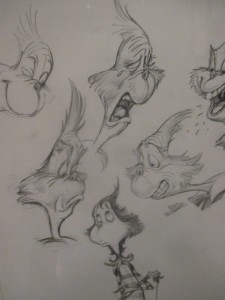

Peanuts
The Peanuts Movie, directed by Steve Martino, was released in 2015. It was inspired by the Peanuts comic strip, 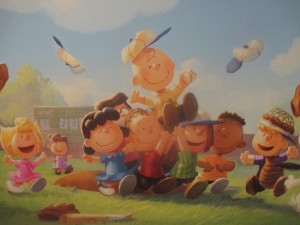 which was written and drawn exclusively by Charles M. Schulz for its 50 year run, from 1950 to 2000. Each week, in just a few panels, Charles M. Schulz drew the adventures of Charlie Brown, an insecure and frequently unlucky boy, and his famous companion Snoopy, an „almost philosophic“ dog gifted with a vivid imagination. These strips were filled with minimalistic characters and simple backgrounds. To create a stylisitic link between their film and the original style of the Peanuts` strips, Blue Sky Studio`s artists chose to emulate the way Schulz drew his characters and enviromnets whenever possible. That meant the characters would almost always be facing the camera, and would only be viewed from afew specific angles: only those that Schulz had drawn. It also meant utilizing hand-drawn ink lines in their original concept artworks whenever possible, even including them right in the actual animation. Finally, they chose a style for the environments that was inspired by the comic; the backgrounds never upstage the characters. Their palettes are made up of paste shades and luminous atmospheres in harmony with the mood of each scene – whether it is humorous or dreamlike – but like the comic, they complement and support the character`s bold primary colors without overpowering them. The result of this clever balance of traditional drawings and computer-generated graphics is a visual richness that is absolute unique. Director Steve Martino wanted to give the impression that the film`s universe had been hand-drawn by Charles Schulz himself.
which was written and drawn exclusively by Charles M. Schulz for its 50 year run, from 1950 to 2000. Each week, in just a few panels, Charles M. Schulz drew the adventures of Charlie Brown, an insecure and frequently unlucky boy, and his famous companion Snoopy, an „almost philosophic“ dog gifted with a vivid imagination. These strips were filled with minimalistic characters and simple backgrounds. To create a stylisitic link between their film and the original style of the Peanuts` strips, Blue Sky Studio`s artists chose to emulate the way Schulz drew his characters and enviromnets whenever possible. That meant the characters would almost always be facing the camera, and would only be viewed from afew specific angles: only those that Schulz had drawn. It also meant utilizing hand-drawn ink lines in their original concept artworks whenever possible, even including them right in the actual animation. Finally, they chose a style for the environments that was inspired by the comic; the backgrounds never upstage the characters. Their palettes are made up of paste shades and luminous atmospheres in harmony with the mood of each scene – whether it is humorous or dreamlike – but like the comic, they complement and support the character`s bold primary colors without overpowering them. The result of this clever balance of traditional drawings and computer-generated graphics is a visual richness that is absolute unique. Director Steve Martino wanted to give the impression that the film`s universe had been hand-drawn by Charles Schulz himself.
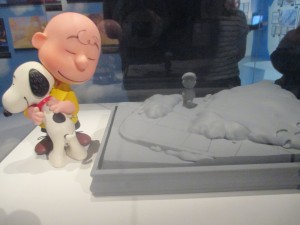
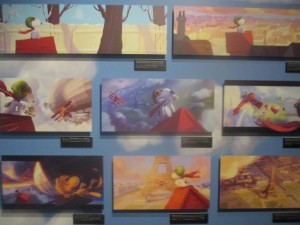
(redaktionelle Bearbeitung für den INDAC-Blog: Karin D. Angele)

